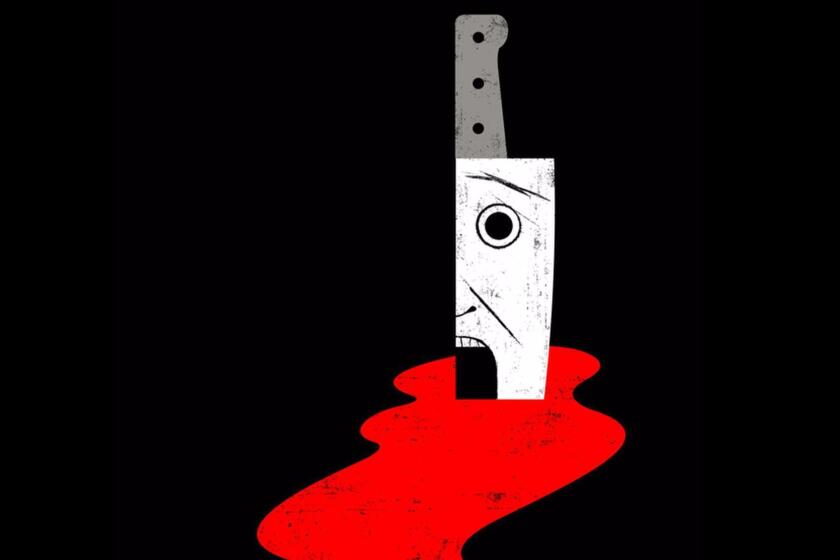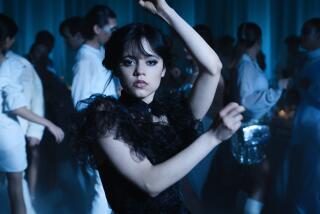Column: How horror took over television
Television has been described in many ways over the past 15 years, ranging from the complimentary — golden, peak, prestige, renaissance — to the worrisome — splintered, fragmented, overwhelming.
A florid list to which we must now add “horrified.” Television in 2019 is horrified.
No, not the news cycle. (Well, yes, the news cycle, but that’s another story.) Horrified as in an industry-wide embrace of supernatural beings that are not essentially lovable metaphors for high school angst or star-crossed love, but actual creepy, scary, don’t-look-now monsters.
Demons, witches, zombies and assorted vengeful spirits who live under rocks, in sinkholes, haunted houses and the skins of humans they have ingested one way or the other haunt our TV screens and hand-held devices (which they occasionally use to send desperate or super-creepy messages).
Consider this: There are currently three Stephen King-inspired series on television: “Mr. Mercedes” (Directv’s Audience), “Castle Rock” (Hulu) and “Creepshow” (Shudder). Next year, barring the cancellation of any or all of these, there will be six, including “The Stand” (CBS All Access), “Lisey’s Story” (Apple TV+) and “The Outsider” (HBO).
Six!
With Halloween fast approaching, the TV viewer’s thoughts shift from the usual prestige drama to things that go bump in the night.
King is the most adapted writer of our time. Seriously, there has been a King adaptation in theaters and/or television every year since 1979. Some years there have been as many as six films and series. But never six series alone (with at least three films also on the books).
So if you’re wondering what will be holding the teetering tower of ever-increasing television platforms together, it’s not Dick Wolf or J.J. Abrams or even Sherlock Holmes. It’s Stephen King, and the genre he represents.
Horror has ever lurked in the dark corners of television, regularly reminding the world of its power with sudden, ferocious attacks — “Kolchack: The Night Stalker,” “Buffy the Vampire Slayer,” “Supernatural,” “True Blood,” “American Horror Story” “The Walking Dead.” But it was never taken as seriously as, say, police and medical procedurals or political satire or historical dramas or hour-long explorations of how difficult it is to be a white guy in the CIA/mob/Old West/world of advertising, fire-fighting or plastic surgery.
When “American Horror Story” debuted on FX in 2011, creators Ryan Murphy and Brad Falchuk literally piled in all their favorite horror stories into the first season — who knew if they would get a second?
This week “AHS,” now in its ninth season, aired its 100th episode, while Murphy has moved on to more topical horrors, and Netflix, with “The Politician.”
Which is probably smart. Monomaniacal rich folks and their family empires (see also: “Succession”) are pop culture’s new vampires, while actual monsters have turned television into an at times literal hellscape.
Certainly that’s what’s happened at AMC, where prestige — “Mad Men” and “Breaking Bad,” “Better Call Saul,” “Halt and Catch Fire” — has surrendered to “The Walking Dead,” “Fear the Walking Dead,” “Preacher,” “The Terror,” “NOS4A2” and “A Discovery of Witches.”
Meanwhile, “more is more” Netflix has piled on not only original homegrown scares — “Stranger Things,” “The Haunting of Hill House,” “The Chilling Adventures of Sabrina” — but also subtitled supernatural programs, including “Marianne” (French), “Dark” (German), “Diablero” (Spanish), “Kingdom” (South Korean) and, my personal favorite, “Black Spot” (French-Belgian). (For the record, Sundance went international first with the French-language “Les Revenants,” although the series is now, of course, available on Netflix.)
Hulu’s got “Light as a Feather,” “Into the Dark” and, if we’re going to get political, “Handmaid’s Tale”; Amazon has “Lore” and a host of other non-original content, including “Bates Motel.” “American Horror Story” paved the way for “The Strain” and “What We Do in the Shadows” on FX. Geena Davis starred in the now-canceled Fox series “The Exorcist” and Showtime recently announced that there will be a fourth season of its gone-but-not-forgotten “Penny Dreadful.” Even the creators of “The Good Wife” recently went evil with “Evil” on CBS.
And that’s only the tip of the werewolf’s ear. What in Satan’s name is going on?
The easy answer? Digital effects. They are better, and cheaper, than they’ve ever been, which is a boon for all genres, especially fantasy, sci-fi and horror. The transformation that shocked “An American Werewolf in London” audiences all those years ago is now standard fare, as are string-free bats, monsters assorted, people with eyes that go black, bloody or literally blazing, and all manner of spooky houses or fiery hell gates.
With fear of the cheese-factor lessened, and the R-rated allowances of cable and streaming, writers who in the past wouldn’t have considered dabbling in the occult are free to create the sort of stories and characters once reserved for serious dramas (while also, it must be said, exploring the shock value of butchery).
Shorter seasons and the binge model also help. The excruciating tension of the very best horror is created more by what is not seen than what is, a game of hide and seek that has been, historically, much harder to sustain in episodic TV than in a two-hour or so film. Not surprisingly, many broadcast network scare-fests, including “Buffy,” “Supernatural” and, more recently, “Hannibal” and “Grimm,” were essentially procedurals with monsters. With 10 or fewer episodes, television horror can follow the same “What is that?” “It’s just the wind” beats as film — which is also experiencing something of a horror renaissance. The success of “Get Out” made room for prestige frights like “Hereditary,” “Midsommar,” “Us” and “Parasite” while the inevitable King adaptations, “It” and to a lesser extent “Pet Sematary,” opened the door for “Scary Stories to Tell in the Dark” and “Ready or Not.”
(If I start listing all the scary movies being made or resurrected on streamers, I will be found years hence as a withered skeleton in a locked room somewhere.)
After “Get Out” premiered, Times film critic Justin Chang proclaimed horror as the genre of the Trump administration and that is certainly proving to be true. Scary stories have always been a way to explain a world in which bad things happen for no easily explained reason, to explore our collective anxieties and fears.
From “I Married a Witch” to “Twilight,” we have often humanized our monsters. Certainly, television during the Obama administration was also full of witches, vampires, werewolves and even zombies who were struggling just like the rest of us. And “Sabrina,” “iZombie” and other series, most aimed at younger audiences, still carry a “Harry Potter” torch for supernatural powers that can be used to fight for good. But increasingly, our stories describe evil that is real and bent on absolute destruction.
The creatures of this new age of horror cannot be psychologically understood, tamed by love, socialized or brought to justice. They can only be seen for what they are and destroyed.
Make of that what you will.
Horror is cinema’s great equalizer. No one is safe. Whether a parable for troubled times or a scream-filled escape, film’s masters of scare bring us tales that frighten us silly, explore the unspeakable and remind us that, unlike the unlucky souls onscreen, we are the ones still left alive. Though the form is often maligned, horror has never been more robust in ideas -- and popularity. With horror’s highest-grossing film still in theaters, we take a look at the monsters we love to fear. For American horror stories are not only having a moment, they might, in fact, turn out to be the signature genre of the present moment.
More to Read
The complete guide to home viewing
Get Screen Gab for everything about the TV shows and streaming movies everyone’s talking about.
You may occasionally receive promotional content from the Los Angeles Times.








